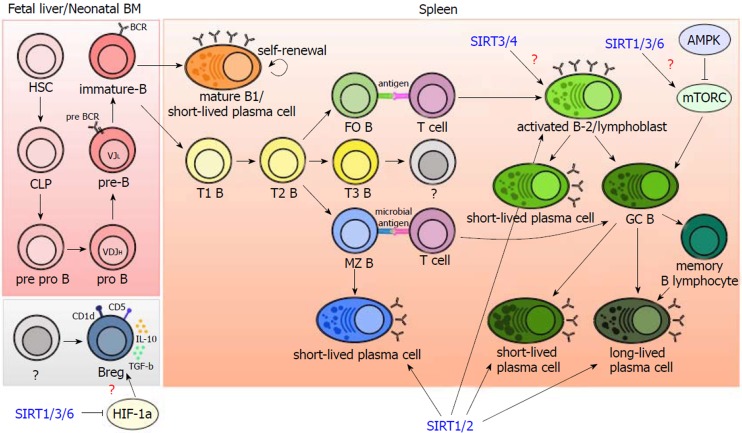Figure 2.
Sirtuins and B lymphocytes. B lymphocyte development begins in the fetal liver or bone marrow and continues in the periphery. B-1 and B-2 B lymphocytes differentiate into ASCs by distinct pathways. The origin of Breg cells is still not precise. Despite the role of SIRTs in healthy B lymphocytes have not been adequately investigated, some studies have described some functions in a disease context. SIRT1 and 2 inhibition are essential to treat CLL, although other studies show that SIRT1 is important at some point of ASCs differentiation. Moreover, since AMPK-mTORC1 axis regulates GC reactions and antibody production, it suggests that SIRT1 (or SIRT3/4) also coordinate this process. Glutaminolysis was shown to be an essential metabolic pathway to enhance proliferation of Burkitt lymphoma-derived B lymphocytes. Thus, SIRT3 and 4 might play roles in the pathogenesis by activating or inhibiting, respectively, the GDH activity. Additionally, HIF-1α was shown to be essential to IL-10-producing Bregs development, suggesting that SIRT1/3/6 are downregulated in these populations. The question marks indicate speculative roles of SIRTs. AMPK: AMP-activated protein kinase; ASCs: Antibody-secreting cells; B: B lymphocytes; BCR: B cell receptor; Breg: B regulatory lymphocytes; CLL: Chronic lymphocytic leukemia; CLP: Common lymphoid progenitor; FO B: Follicular B lymphocytes; GC: Germinal center; GDH: Glutamate dehydrogenase enzyme; HIF-1α: Hypoxia-inducible factor 1-alpha; HSC: Hematopoietic stem-cell; mTORC1: Target of rapamycin complex 1; MZ: Marginal zone; SIRTs: Sirtuins; T1/T2/T3: Transitional stages 1, 2 and 3, respectively, of B lymphocytes.

